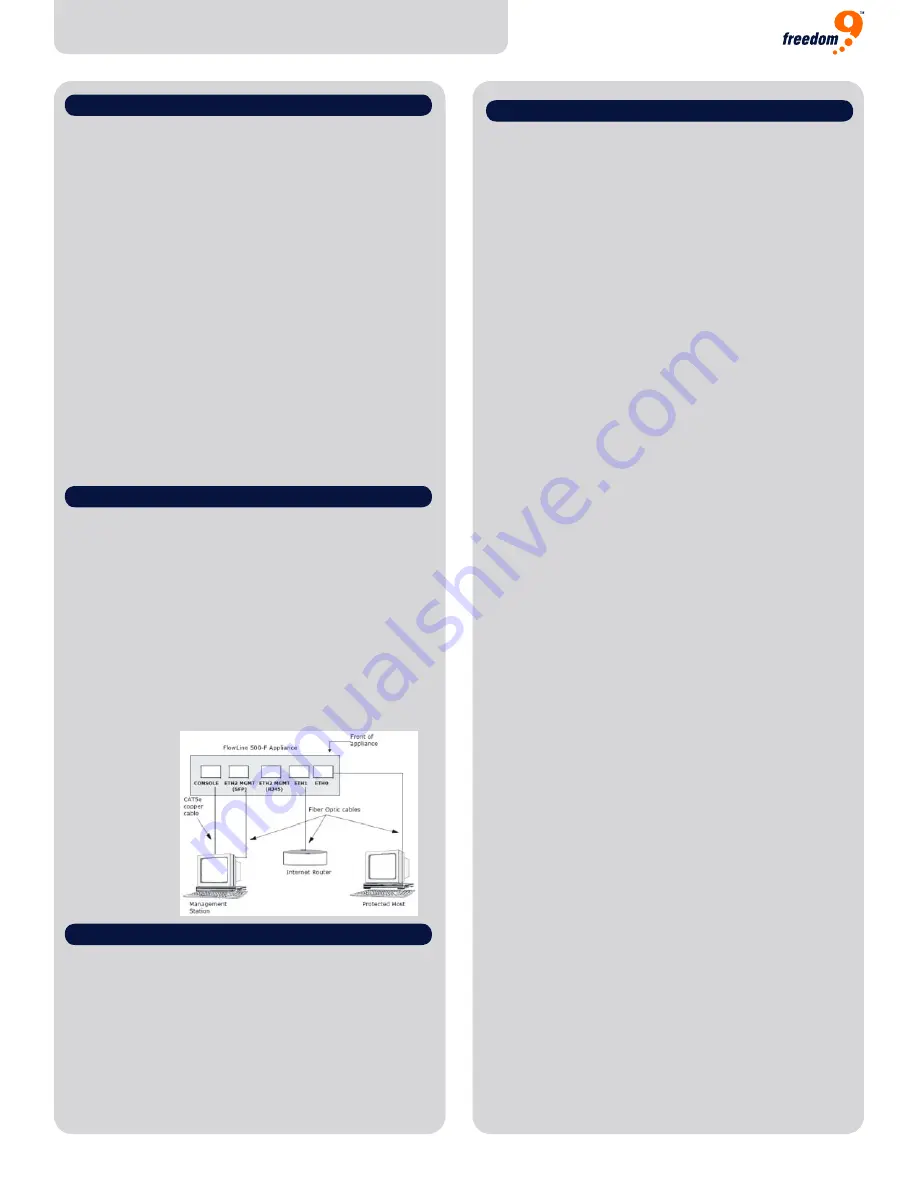
Quick Install Guide
freeGuard
Slim 300
Revision 1.0 Specifications are subject to change without notice. Copyright 2008 Freedom9 Inc.
freedom to succeed
1.
Plug one end of the Ethernet cable into the interface
(eth0) on the front panel of the appliance
2.
Plug the other end of the Ethernet cable into the
Ethernet port on the management station
3.
Turn on the appliance and the management station if
they are not already on
4.
Adjust the IP Address of the management station to
192.168.1.10/24
5.
Using a web browser, point the browser to
http://192.168.1.1
6.
You will be prompted to enter a user name and
password. Enter the following:
User name:
admin
Password:
admin
7.
Change the default password for the freeGuard Slim
300 appliance by going to the
System > Admin >
Administrators
page from the menu
8.
Select Admin in the User Name field. Enter the old
password and the new password. Click Apply.
B-Option2: WEB-BASED CONFIG:
www.freedom9.com
1-888-998-9189
Page 2
D. CONFIGURATIONS (Continued):
Changing the Default ETH2 MGMT to Use a Fiber
Optics Interface
You can use the following command:
set interface eth2 link-type fiber
Setting the time on your appliance
The default setting for the freeGuard Slim 300 appliance is
GMT. If you want to change this setting, use the following
command:
cli->set clock 07/26/2007 12:00:00
Enable logging
Use the following commanc to enable logging for monitoring,
trouble shooting and tracking. Set up a Syslog server to collect
logs.
1.
You can provide the IP Address of a syslog server using the
following commands. The default is enabled.
cli-> set syslog enable
cli-> set syslog config 192.168.65.199
2.
Once the syslog server is enabled, you can enable log
messages to be sent to the syslog server as follows:
cli-> set log module policy level
information destinaton syslog
Every new connection will now be sent to the syslog server
3.
If you do not have a syslog server and want to enable
internal logging on the appliance, you can enable internal
logging using the following command:
cli-> set log module policy level
notification destination internal
4.
To view the internal log messages, use the following
command:
cli-> get log message
Jul 26 12:02:09 2007 freedom9 id=slim100
policy[138] [INFO] proto=17
re=192.168.65.174:137 dst=192.168.255:137
packet dropped due to policy deny!
Default Configurations
The following are the default settings used when the appliance
is powered on for the first time. Be sure to have your manage-
ment IP Address available during configuration.
Mode:
Transparent
Zone for eth0:
Global
Zone for eth1:
Global
Zone for br0:
Global
IP Address for br0:
192.168.1.1/24
Policies:
NetFlow is enabled
Top-talkers is enabled
Management:
Bandwidth management
features are disabled.
The following management protocols are
enabled:
SSH
Syslog
SNMP (Pubic community)
HTTP and HTTPS
Ping
Setting up the syslog and NetFlow servers
Use the following CLI commands to set up your syslog and
NetFlow servers:
set syslog config ip-address
set netflow config ip-address port port
C. CONNECTING TO OTHER DEVICES:
Once the power is connected to the appliance, you can
connect it to other network devices. Use either of the
two Ethernet interfaces labeled eth0 or eth1. These
interfaces allow you to connect to other network devices
as required. You can use ETH2 MGMT as a management
port, either SFP or RJ45 port.
Figure 4 displays the eth1 interface connected to an
Internet router using a fiber optic cable, while the eth0
interface is connected to a switch on your local area
network (LAN) using another fiber optic cable
Figure 4
D. CONFIGURATIONS:
Initial Configuration of the Appliance
The default configuration for ETH2 MGMT is RJ45 port, based
on your deployment scenario, additional configuration may be
required.
To Verify the Default Configuration
You can use the follow command to verify the default
configuration:
cli->get config
set interface eth2 ip 192.168.1.1/24
set interface eth2 manage http












